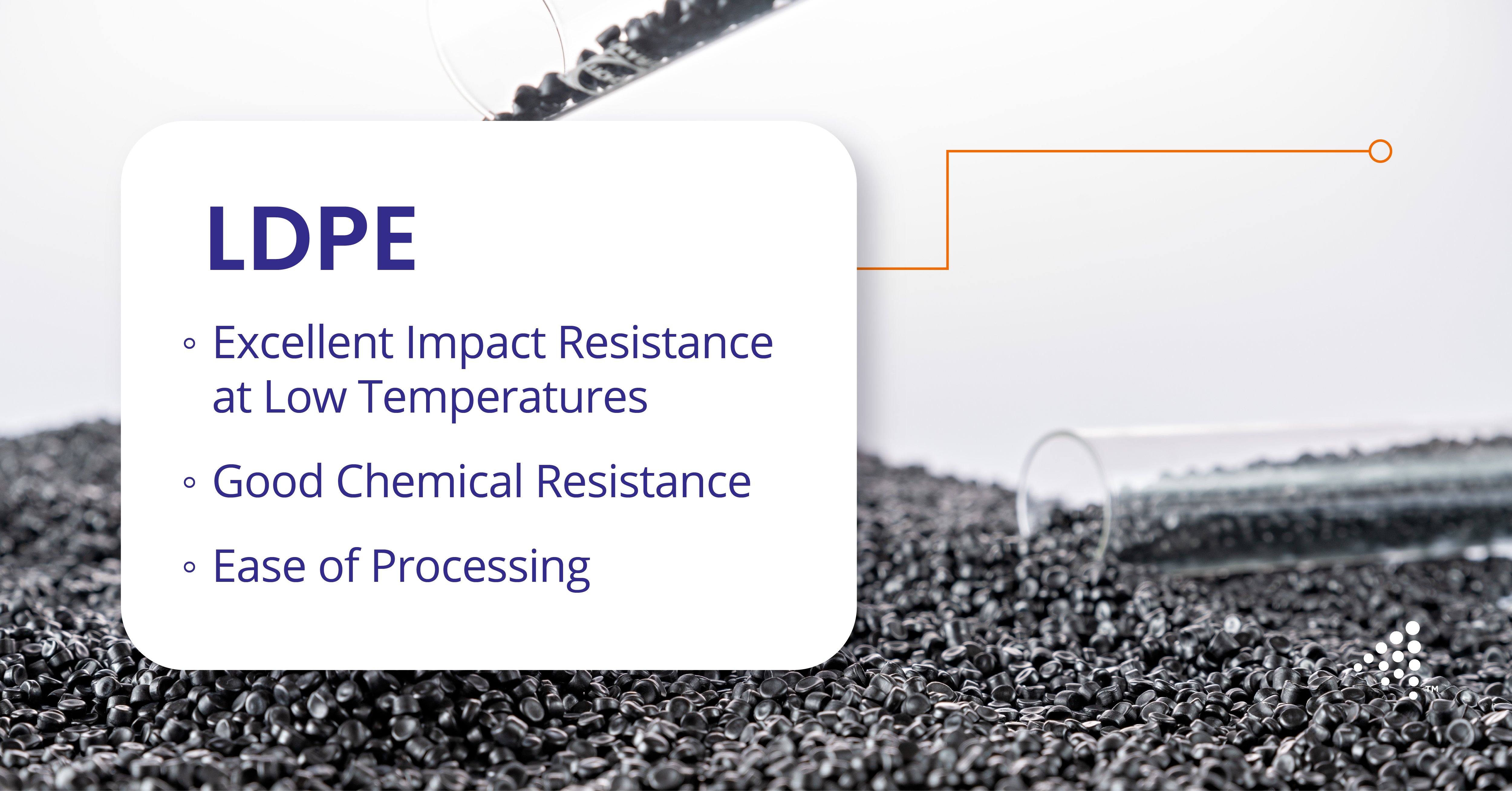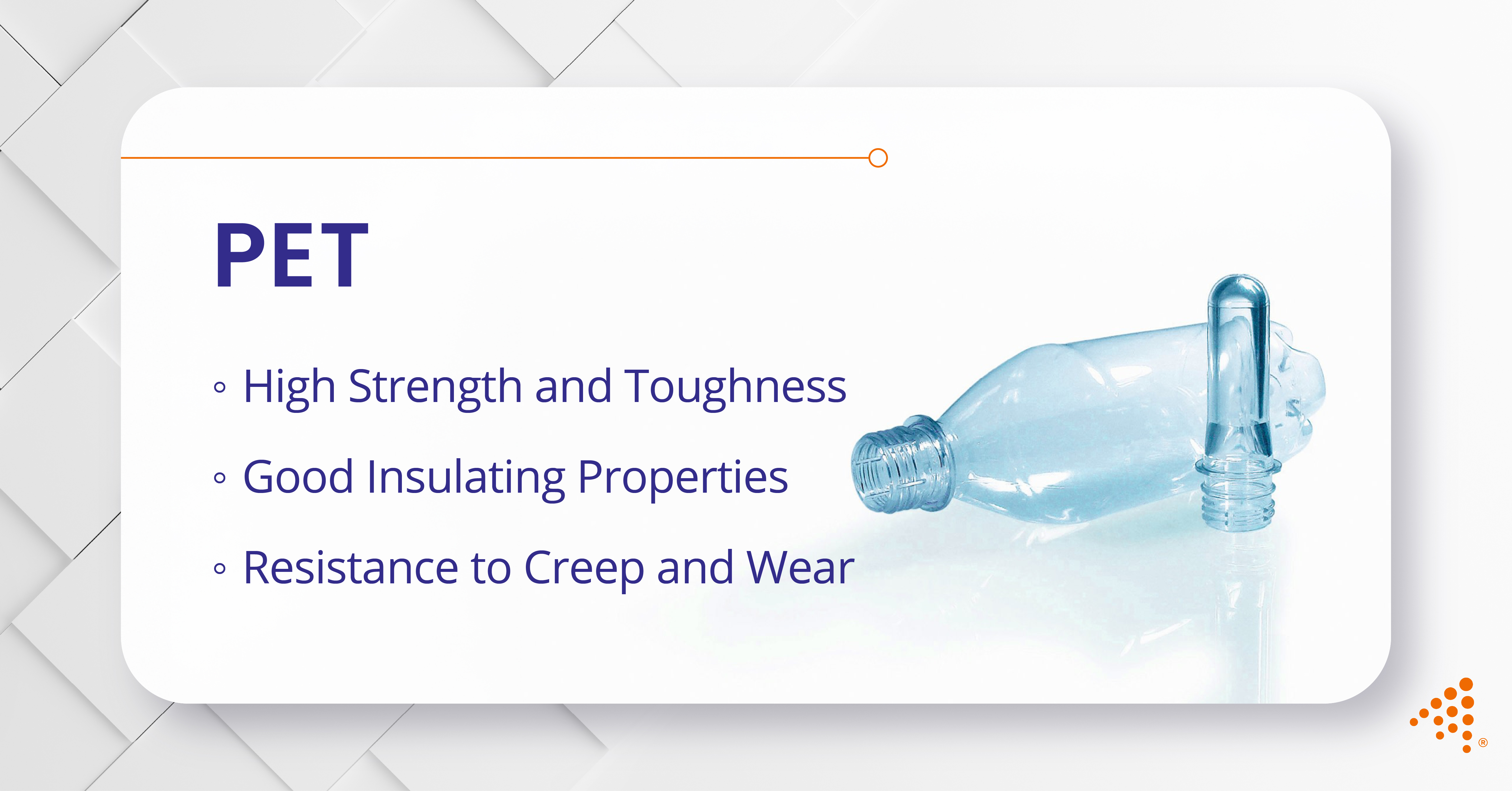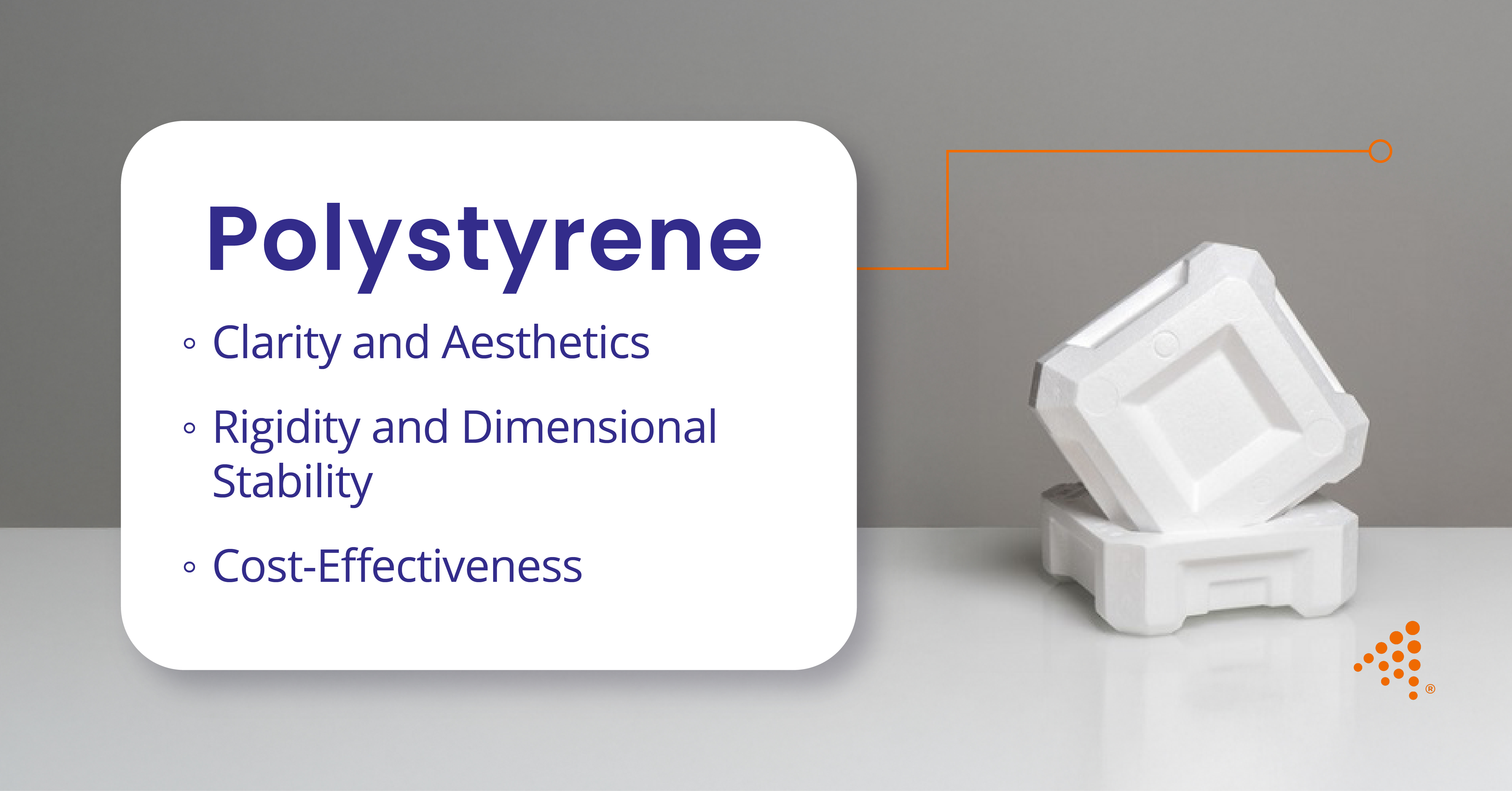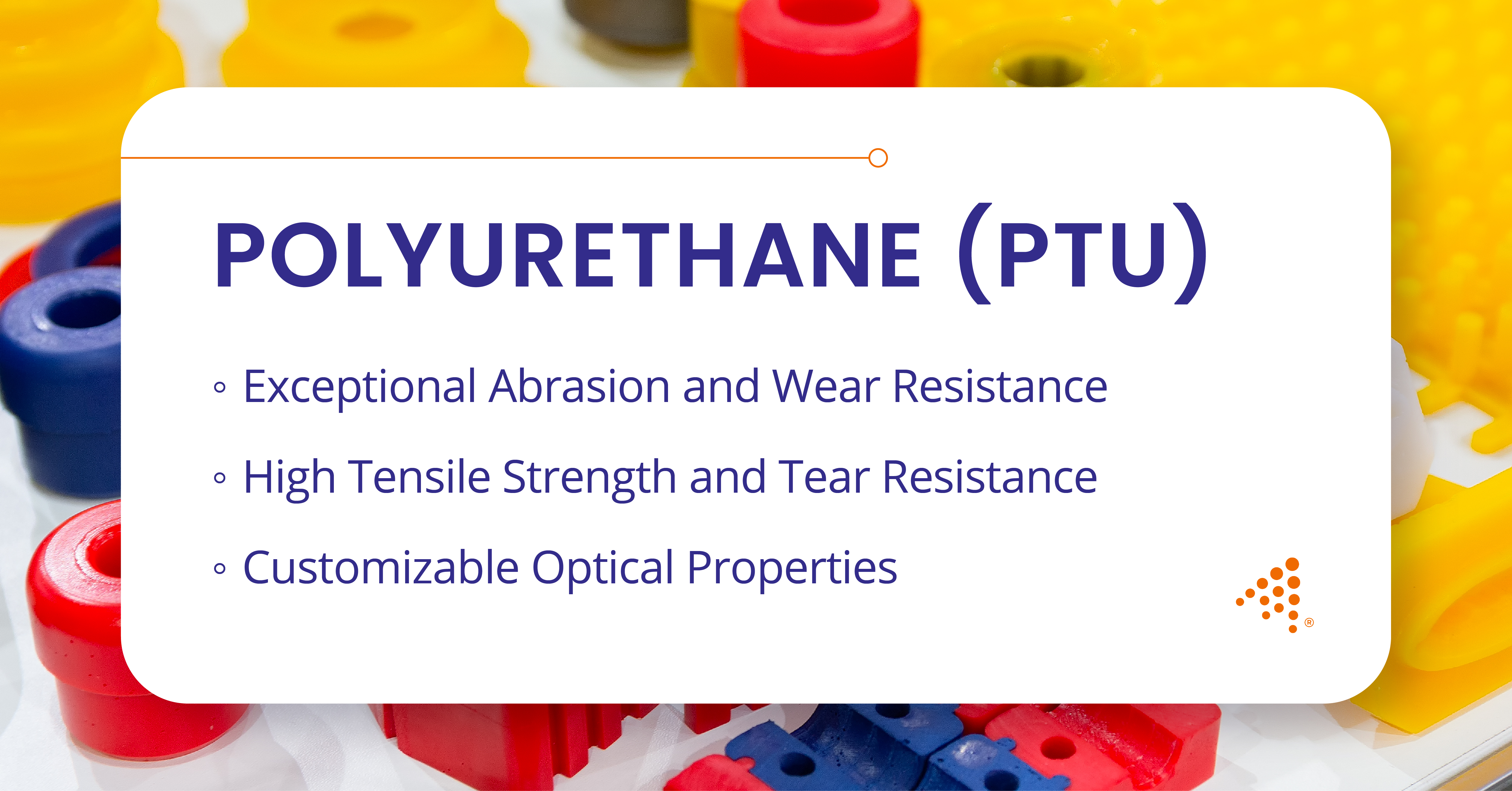PET: Versatile Resin for High-Volume Manufacturing
Polyethylene Terephthalate (PET) is a widely used thermoplastic resin known for its strength, chemical resistance, and versatility in high-volume...
6 min read
Nick Erickson : May 19, 2025 8:50:00 AM

Low-Density Polyethylene (LDPE) is a flexible, cost-effective thermoplastic resin commonly used in a variety of industries. Known for its pliability, toughness, and ability to perform in low-temperature environments, LDPE is an ideal choice for applications that require flexibility and affordability. Its compatibility with processes like Design for Injection Molding (DfIM) and Prototype Injection Molding makes it especially valuable for short-run or low-volume production.
LDPE is valued for its outstanding flexibility and softness compared to other polyethylene types. Its low crystallinity gives it a pliable nature, making it ideal for products that require bending, stretching, or sealing. This unique flexibility supports its use in films, tubing, and wire coatings.
LDPE maintains strong impact resistance even in cold environments. It resists cracking and breakage when dropped or stressed, making it suitable for outdoor packaging, protective films, and containers that may experience rough handling or extreme temperature swings.
LDPE performs reliably when exposed to a range of chemicals, including alcohols, acids, and diluted alkalis. While it’s not as resistant to hydrocarbons or strong oxidizers as HDPE, it offers sufficient protection for many common packaging and tubing applications in industrial and laboratory environments.
With very low moisture absorption, LDPE provides a dependable barrier against water and vapor. This makes it ideal for food packaging, medical pouches, and any product where maintaining sterility or shelf life is important.
LDPE is one of the easiest plastics to process through injection molding services, extrusion, and film blowing. It flows well at relatively low temperatures, allowing manufacturers to produce thin, consistent films and complex shapes quickly and efficiently. This ease of molding also supports injection molding tooling and tooling services that allow for quicker transitions from prototype to production.
As its name implies, LDPE has a lower density than HDPE and many other thermoplastics. This makes it lightweight and easy to handle, which is advantageous for packaging, shipping, and consumer applications where reducing material weight is important.
LDPE can achieve a semi-transparent, glossy appearance that enhances product aesthetics—especially in flexible packaging. While it’s not as optically clear as some other plastics, its surface quality supports clean, attractive designs for both medical and commercial uses.
LDPE offers strong electrical insulation and dielectric properties, which is why it’s commonly used in cable jacketing and insulating layers for low-voltage wiring.
LDPE is available inFDA-Compliant Manufacturing and ISO-Certified Manufacturing formulations. These versions meet stringent standards and are widely used in sterile packaging, disposable labware, and pharmaceutical film products manufactured via Medical Injection Molding and FDA Injection Molding techniques.
Talk to our materials engineering team for personalized guidance on LDPE and other performance polymers suited to your industry.
LDPE’s signature blend of flexibility, chemical resistance, and ease of processing makes it an indispensable material across industries—from medical manufacturing to packaging and consumer goods. Its soft texture and barrier properties allow it to perform well in both disposable and durable applications. Below are some of the most notable and widely adopted uses of LDPE:
LDPE is frequently used in the medical field for flexible packaging, sterile barrier systems, and lab containers, especially when produced via medical injection molding to ensure precision and compliance. Its compatibility with gamma radiation and ethylene oxide sterilization—along with its softness and transparency—makes it ideal for pharmaceutical pouches, IV bags, disposable gloves, and dropper bottles.
One of LDPE’s most common end uses is in film products such as plastic bags, shrink wrap, pallet stretch film, and food packaging. Its ability to create thin, lightweight films that resist tearing and moisture makes it a go-to material for both industrial and retail packaging.
In medical, laboratory, and industrial environments, LDPE is used for flexible tubing and squeezable bottles. Its resilience and chemical resistance allow it to safely transport and store liquids, including acids, disinfectants, and other sensitive substances.
Thanks to its high dielectric strength and flexibility, LDPE is commonly used as an insulating material for wires and low-voltage cables. It maintains performance even under mechanical stress and offers protection in both indoor and outdoor settings.
LDPE is widely used in agriculture for greenhouse films, mulch films, pond liners, and silage wrap. Its UV-resistant variants provide protection from the elements while maintaining durability in challenging outdoor environments.
Everyday items such as zip-top bags, garment bags, squeezable condiment bottles, and flexible packaging pouches are made from LDPE. Its ability to conform to a wide range of product shapes while offering sealing properties makes it a favorite for convenience and hygiene.
In construction, LDPE is used for vapor barriers and protective sheeting. Its role is often part of Digital Manufacturing Solutions aimed at delivering lightweight, waterproof layers efficiently.
LDPE is found in toys, kitchenware, and other household goods that benefit from its soft feel and resistance to breakage. Its ability to remain safe and durable in repeated-use environments makes it well suited for child-safe and everyday items.
While LDPE naturally offers flexibility, clarity, and chemical resistance, it can be customized further with a range of additives and processing aids to meet specific performance requirements. These enhancements are especially useful in medical, packaging, agricultural, and industrial settings where durability, hygiene, or environmental conditions demand additional functionality.
LDPE’s vulnerability to sunlight can be mitigated with UV stabilizers, which protect the polymer chains from degrading under prolonged exposure. These additives are crucial in outdoor applications like agricultural films, greenhouse covers, and construction barriers.
Pigments, dyes, and opacifiers are commonly blended into LDPE to create vibrant or functional color options. This is useful not only for branding and aesthetics, but also for identification purposes in medical and industrial products.
To inhibit microbial growth on LDPE surfaces, antimicrobial agents can be incorporated into the resin. These additives are particularly beneficial for food packaging, medical devices, and reusable consumer products that demand enhanced hygiene.
Slip agents reduce surface friction between LDPE films, making them easier to process, handle, or package. Anti-blocking agents help prevent film layers from sticking together—an important feature in applications like plastic bags and shrink wrap.
LDPE can be modified with antistatic agents to reduce the buildup of static electricity. This is valuable in electronic packaging and cleanroom applications where dust attraction or electrostatic discharge could pose risks.
Foaming agents are added to LDPE to produce lightweight foam materials, often used in protective packaging, insulation, and cushioning products. These agents help create air-filled structures without compromising the polymer’s resilience.
For uses that require enhanced fire safety—such as wire insulation or construction films—LDPE can be compounded with flame retardants. These additives slow down ignition and reduce flame spread in case of exposure to heat or fire.
To improve extrusion and molding efficiency, processing aids like lubricants and mold release agents can be included. Fillers such as calcium carbonate or silica may also be added to adjust stiffness, opacity, or cost-effectiveness, depending on the end-use.
Connect with Aprios today for expert support in design, prototyping, and full-scale production using custom LDPE formulations.
LDPE offers an attractive balance of flexibility, chemical resistance, and processability, but like any material, it comes with limitations. These drawbacks are important to consider when evaluating LDPE for applications that demand higher strength, temperature resistance, or long-term structural integrity.
One of the primary limitations of LDPE is its relatively low melting point—around 105–115°C (221–239°F). This restricts its use in high-temperature environments or settings that require heat sterilization, such as certain medical or food-contact products.
Compared to other polyethylenes like HDPE or engineering plastics such as ABS or nylon, LDPE has lower tensile strength and impact resistance. It is more prone to stretching, tearing, or puncturing under mechanical stress, which makes it unsuitable for load-bearing parts or rugged contexts.
LDPE’s softness and flexibility also contribute to dimensional instability under stress or temperature changes. This can be a concern in fields that require precise fit, form, or rigidity, particularly over time or under cyclic loading.
Due to its low surface energy, LDPE resists most adhesives, inks, and coatings. This can complicate secondary processes like labeling, printing, or painting. Surface treatments, such as corona discharge or flame treatment, are often required to improve adhesion.
LDPE’s affordability, flexibility, and processability make it a top material for companies developing medical devices, packaging products, or flexible parts. It supports end to end manufacturing services, including Additive Manufacturing for Production, Quick Turn Injection Molding, and Insert Molding for Medical Devices.
At Aprios, we specialize in material selection, design for manufacturing solutions, and dfm development services to help you get the most out of LDPE. Whether you're exploring 3D Printed Prototypes, Carbon DLS Prototyping, or full-scale additive manufacturing services, we offer the ISO-Certified Manufacturing Company support you need.
Contact Aprios for expert guidance tailored to your next medical, consumer, or industrial project.
You can also view our Material Selection tool.

Polyethylene Terephthalate (PET) is a widely used thermoplastic resin known for its strength, chemical resistance, and versatility in high-volume...

Polystyrene (PS) is a synthetic aromatic hydrocarbon polymer made from the monomer styrene. It is a versatile and widely used thermoplastic that can...

Polyurethane (PTU) is a uniquely versatile class of polymers that exists in a variety of forms, from flexible and rigid foams to durable elastomers...